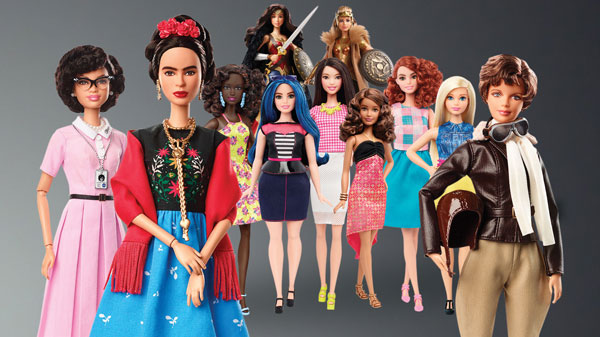Although having turned 60 last month, Barbie, the most globally recognisable doll, remains as pneumatic, youthful and preternaturally curvy as she did back in 1959. Idealised, iconic and the cause of incandescent rage in certain quarters (largely on account of the way she has enshrined white domestic goddessness in the minds of several generations), she has, however, veered into less familiar territory along the way.
Indeed, while finding her way into more than 150 countries over the last six decades, she has been serially reinvented in line with changing times, passing fads and, seemingly, overly strong medication. Now, to pay tribute to her 60 years at the top of the world’s must-have Christmas lists, we take a brief gambol through some of the more bizarre Barbie-isms, less clean cut Kens and sundry other oddities from the first three-score years of the world’s favourite doll.

Original Barbie (1959)
Barbie courted controversy pretty much from the off. Although presented as a wholesome all- American girl, her creator – Ruth Handler – based her look on Bild Lilli, a German doll conceived as “a gold digger, exhibitionist and floozy”, inspired by a popular newspaper cartoon strip of the same name. While the look and proportions of Handler’s doll were very similar to her Teutonic counterpart, her positioning and brand values were, of course, very different. Perhaps fearing the seedy origins of their cash cow would, one day, undermine sales, Mattel (Barbie’s manufacturer) acquired the rights to Bild Lilli in 1964 and promptly shut down its production.

Growing-up Skipper (1975)
Skipper, Barbie’s younger and definitely not-so-sexy (that was the brief apparently) sister was adrift on the unpredictable tides of adolescence back in the ’70s when Growing-up Skipper debuted. This fairly bizarre doll allowed its owners to transform Skipper from a “cute, little girl” to a “tall, curvy teenager” by just pulling on her arm, a prompt that saw her breasts instantly emerge. How much confusion this caused among the prettynearly- pubescents of the time goes unrecorded, as does the levels of limb-tugging-related A&E admissions.

Sun Sensation Ken (1991)
Prior to 2004, when Mattel announced that Barbie and Ken had ‘officially’ split, it had never actually been confirmed that the two were indeed a couple, so it’s fair to assume that this 1991 version of the doll’s bendable beau may have spent some time “finding himself” in the nightclubs of West Hollywood when he wasn’t having wholesome fun with his plastic paramour. After all, the ’90s was the decade of the metrosexual, and why should Ken have been the only one to miss out on all the fun? Whether it was just one neon mesh shirt, a few nights of exciting experimentation or finally becoming fully true to himself, we support Ken no matter what.

Midge and Mini-Midge (2002)
Some 39 years after first being added to Barbie’s entourage, Midge – the doll’s redheaded best friend – caused quite a stir with her 2002 pregnancy. Dispatched from the factory with a detachable womb, Midge and her child-to-be, Nicki, were seen as somewhat inappropriate for children – not because of the several biological inaccuracies involved, but rather because Mattel had failed to put a ring on her finger. Society surely shook.

Barbie by Christian Louboutin (2009)
Following Mattel’s 2009 collaboration with Christian Louboutin, the iconic Parisian fashion designer, Barbie bounced into stores in a sleek black catsuit, with four standby pairs of stilettos waiting in the wings. No longer the girl-next door, this redheaded Barbie looked more bound for a pre-booked BDSM basement session than for any hearty beach buggy shenanigans with Ken and Skipper.
Mexico Barbie 2012
Launched back in the ’80s, the long-running Barbie Dolls of the World series has seen the US iconess reimagined as everything from a Native American to an Egyptian princess. It was her 2012 Mexican makeover, however, that proved to be the most controversial. Sporting an already-dated fiesta dress and with a cute little Chihuahua tucked underneath her arm, it was felt that the look perpetuated a long-standing – and somewhat offensive – stereotype. Boldly, but perhaps a little unwisely, Mattel’s PR bods defended south-of-the border Barbie on the grounds that many Barbie Dolls of the World came complete with an animal chum. Chinese Barbie, they said, has her own panda – a “for instance” that did far more to fan the flames than dowse them.

Barbie Walk and Potty Pup 2016
In a dolly-digression best filed under “Good Intentions Gone Awry”, this well-meaning attempt to educate young dog owners the importance of scooping up pooch poo could probably have been a little better thought out. At first glance, the message couldn’t be clearer – once Taffy (Barbie’s dog) has been fed his supplied plastic bone, a quick tweak of his tale releases a convincing dollop of doggy droppings. Sadly, sundry big and little brothers took it upon themselves to disrupt the woofer’s workflow, with poor Taffy finding himself fed his own “bottom burgers” on a regular basis. As unedifying as it was non-educational, this particular pet project really ought to have been vetted.
Speaking shortly before she died in 2002, Handler said: “My whole philosophy was that, through the doll, a little girl could be anything she wanted to be”. Sixty years on, as long as those aspirations were limited to S&M superstardom, cultural appropriation or severely disruptive doggy digestive processes , it looks like mission accomplished.
Text: Bailey Atkinson
For the full article, please find the latest issue of Gafencu’s print magazine or the PDF version on the Gafencu app. Download the app from the Google Play Store or Apple App Store




